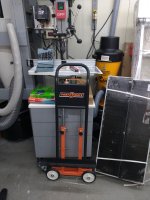ryanjg117
Member
- Joined
- May 18, 2015
- Messages
- 333
I have in my possession a really nice looking, older Powermatic 1150A with the speed adjustment knob at the top. Came with a 1hp, 3ph Baldor motor. I only have single phase 220v in the shop, so I am looking to get a variable frequency drive to run it. AutomationDirect sells a suitable drive for about $130. I plan to mount it on the side of the machine near the existing contactor box.
Just a few questions:
1. Is there any power loss when using a VFD in this manner? What are the drawbacks?
2. I understand I can manipulate motor speed via the VFD knob. However, this drill press already includes the ability to change speeds (while running) using the knob at the top of the drill press. Should I just set this VFD to 100% all of the time, or can I achieve even more granular speed adjustment via the drill press knob + VDF switch?
3. This drill press was missing it's power switch as well. I assume a standard 220v 30a double pole switch like this one would suffice?
I'm considering a couple different drives:
Teco Variable Frequency Drive
AutomationDirect GS1-21P0 MicroDrive
Any thoughts or opinions on either?
Just a few questions:
1. Is there any power loss when using a VFD in this manner? What are the drawbacks?
2. I understand I can manipulate motor speed via the VFD knob. However, this drill press already includes the ability to change speeds (while running) using the knob at the top of the drill press. Should I just set this VFD to 100% all of the time, or can I achieve even more granular speed adjustment via the drill press knob + VDF switch?
3. This drill press was missing it's power switch as well. I assume a standard 220v 30a double pole switch like this one would suffice?
I'm considering a couple different drives:
Teco Variable Frequency Drive
AutomationDirect GS1-21P0 MicroDrive
Any thoughts or opinions on either?

